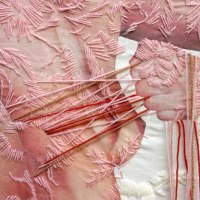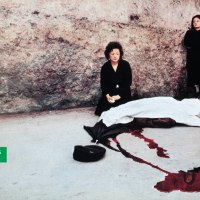Caption (image above): lumen/chemigram (by Sofia Silva)
More about William Miller‘s work here.
William Miller about Ruined Polaroids: “With its first use I realized the camera wasn’t functioning properly. It sometimes spills out 2 pictures at a time and the film often gets stuck in the gears, exposing and mangling the images in unpredictable ways. This is common with Polaroids. I’ve been shooting this SX-70 film my whole life and from my experience at least 5% of the time the images fail for one reason or another. Over time you stop noticing. The failed Polaroids are discarded with the packaging, a statistical casualty of such a complicated mechanism. It was only when my statistical casualties jumped to nearly 100% that I realized that even against my will, this camera was making, totally by chance, some interesting, and occasionally beautiful pictures. It’s this kind of unpredictability that makes old cameras and processes appealing and it wasn’t until I noticed what was happening that I started saving them. I must have thrown out scores of ruined Polaroids over the years. Millions of happy accidents have probably been discarded, unappreciated over the last few decades around the world.” Source: http://lenscratch.com
…

More about Claus Dieter Geissler‘s work here.
…
More about Hannah Fletcher‘s work here.
Hannah Fletcher about Apology: The Art of Scientific Curiosity: “I have inhabited this mind-set of the curious child, the mad scientist. Hungry for knowledge and a desire for innovation and strangeness. I don’t know what I have been searching for particularly, but I have been fascinated by my discoveries. With these findings, I have produced a scientific publication. The book is designed to mimic the style of a scientific study. But, unlike most scientific publications, the work does not provide us with a conclusion. It is not designed to satisfy ones curiosity, but to encourage it. It is a porthole into the scientific, curious, investigative mind-set. The title, Algology, has two meanings. The study of algae and also, the study of pain. It remains ambiguous through out the book as to what I am actually investigating. I have incorporated both definitions for algae and pain. To the same effect, I have also removed the word algae from all of the text, simply referring to ‘it’. This leaves room for the reader to interpret their own understanding of the work and potentially leave them more curious than before.”
…
More info on Forrest K. Elliott‘s portraits here.
Forrest K. Elliott‘s words, almost ten years ago: “Ten years from now, will I be a designer living in Spanish Harlem, or a photographer in a small arrondissement in Paris? Perhaps I will be crossing Jotunheimen on Nordic skis, or finishing my last song of the night (to rousing applause) at a club on a back street in Barcelona. Or, there’s always the possibility that a decade from now you will find me at the front of a well known, New York City law firm practicing human rights law.
I want to explore possibilities, places, the different ways that people shape their lives, and my own potential. I am a traveler. Any of my friends will tell you that at the suggestion of a trip to somewhere new, I am the first to grab my jacket and the car keys.
For me, a journey is not just about going somewhere. Rather, it is about having the time to sink into an unfamiliar environment, taste curious flavors for the first time, gain knowledge and experience that I can then carry home with me. As, despite my love of adventure, I care deeply about creating a home environment that nurtures me and is a reflection of what I love, what interests and inspires me.
The word home might sound dull to some people, but for me, it’s both studio and sanctuary. I say studio because there is no end to the creative pursuits in any given day.” Source: https://forrestkelliott.wordpress.com/
…
More about Ellie Ivanova‘s work here. Her blog here.
…
More about Joli Livaudais‘ work here.
Joli Livaudais, about In the Garden: “This series of layered photographs, photo installations and photo sculptures is created using digital photographs printed on kozo paper, epoxy resin, and other materials including aluminum and gold leaf. For many works in this series, photographs are folded into forms using traditional origami. Select the thumbnail to see the entire image.”
Joli Livaudais, about And Then I Will See: “These photographs are made on black and white 4×5 large format film using a view camera with pinhole and standard lenses. Images are scanned and colored digitally by hand. Photographs are then printed in the historical, handmade process of tri-color gum bichromate. Select the thumbnail to see the entire image.”

































